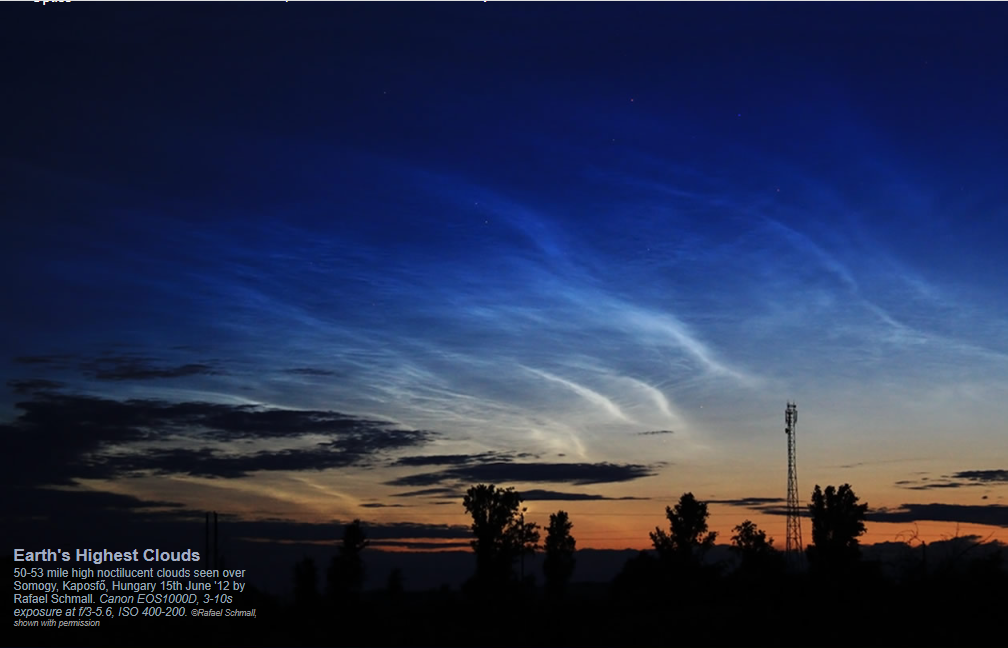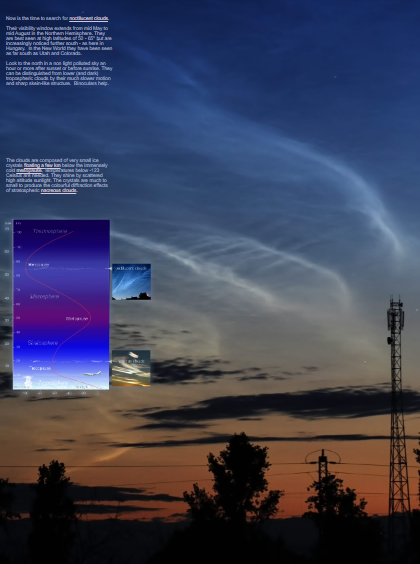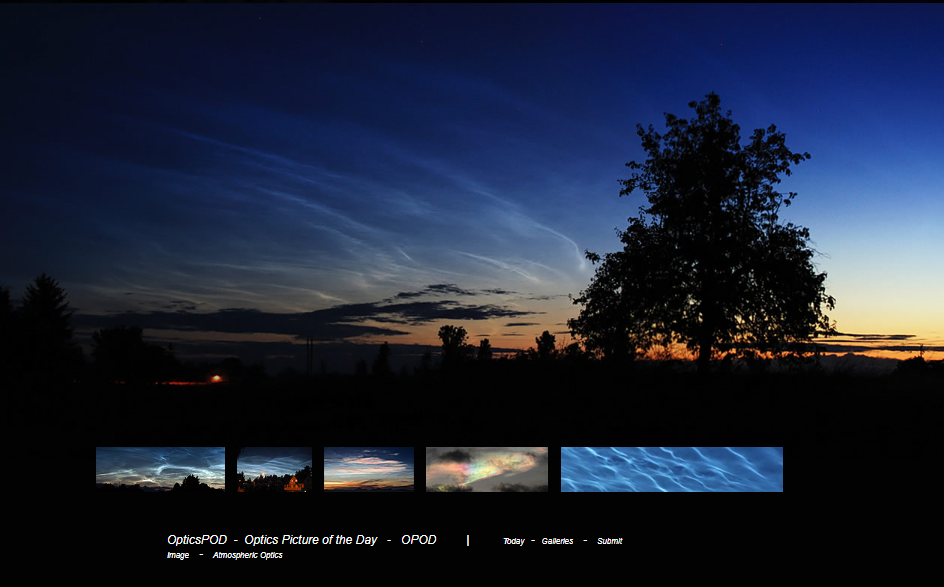OPOD - Noctilucent Clouds
OPOD - Noctilucent Clouds: Earth's Highest Clouds
Noctilucent clouds, also known as polar mesospheric clouds, are a fascinating atmospheric phenomenon that occur at extremely high altitudes. These ethereal clouds can be observed from mid-May to mid-August in the Northern Hemisphere, with their visibility being most prominent at latitudes between 50 and 65 degrees. However, in recent years, they have been increasingly noticed further south, such as in Hungary and even as far as Utah and Colorado in the New World.
To catch a glimpse of these elusive clouds, one should look towards the north in a sky free from light pollution, preferably an hour or more after sunset or before sunrise. Noctilucent clouds can be distinguished from lower tropospheric clouds by their slower motion and distinct skein-like structure. While binoculars can enhance the viewing experience, they are not necessary for observation.
So, what exactly are noctilucent clouds and what makes them so unique? These mesmerizing clouds are composed of tiny ice crystals that float several kilometers below the mesopause, which is the coldest region of Earth's atmosphere. To form, temperatures below -123 degrees Celsius are required. These clouds derive their luminosity from scattered sunlight at high altitudes. However, unlike stratospheric nacreous clouds that produce colorful diffraction effects, the ice crystals in noctilucent clouds are too small to create such vivid displays.
To gain a deeper understanding of this captivating phenomenon, let's delve into some key details:
- Composition: Noctilucent clouds are primarily composed of water ice crystals. However, they may also contain trace amounts of dust and other atmospheric particles.
- Formation: These clouds form when water vapor freezes onto meteoric dust particles present in the mesosphere. The dust particles act as nuclei for ice crystal growth.
- Altitude: Noctilucent clouds reside in the mesosphere, which is located approximately 50 to 53 miles (80 to 85 kilometers) above the Earth's surface. This makes them the highest clouds in Earth's atmosphere.
- Temperature Requirements: The incredibly low temperatures in the mesopause region are necessary for the formation and persistence of noctilucent clouds. These frigid conditions allow water vapor to freeze into ice crystals.
- Seasonality: Noctilucent clouds have a distinct seasonality, with their visibility window spanning from mid-May to mid-August in the Northern Hemisphere. This is because the mesopause region experiences its coldest temperatures during this period.
- Global Distribution: Although predominantly observed at high latitudes, the range of noctilucent cloud sightings has expanded in recent years. They have been documented further south, indicating potential changes in atmospheric conditions.
Noctilucent clouds serve as a captivating reminder of the complexity and beauty of our atmosphere. As scientists continue to study these enigmatic clouds, they contribute to our understanding of Earth's atmospheric dynamics and the impact of climate change on high-altitude phenomena. So, keep an eye on the northern sky during the summer months and marvel at the mesmerizing display of Earth's highest clouds, the noctilucent clouds.

Earth's Highest Clouds
50-53 mile high noctilucent clouds seen over Somogy, Kaposfő, Hungary 15th June '12 by Rafael Schmall. Canon EOS1000D, 3-10s exposure at f/3-5.6, ISO 400-200. ©Rafael Schmall, shown with permission

Now is the time to search for noctilucent clouds.
Their visibility window extends from mid May to mid August in the Northern Hemisphere. They are best seen at high latitudes of 50 - 65° but are increasingly noticed further south - as here in Hungary. In the New World they have been seen as far south as Utah and Colorado.
Look to the north in a non light polluted sky an hour or more after sunset or before sunrise. They can be distinguished from lower (and dark) tropospheric clouds by their much slower motion and sharp skein-like structure. Binoculars help.
The clouds are composed of very small ice crystals floating a few km below the immensely cold mesopause. Temperatures below -123 Celsius are needed. They shine by scattered high altitude sunlight. The crystals are much to small to produce the colourful diffraction effects of stratospheric nacreous clouds.

Note: this article has been automatically converted from the old site and may not appear as intended. You can find the original article here.
Reference Atmospheric Optics
If you use any of the definitions, information, or data presented on Atmospheric Optics, please copy the link or reference below to properly credit us as the reference source. Thank you!
-
<a href="https://atoptics.co.uk/blog/opod-noctilucent-clouds/">OPOD - Noctilucent Clouds</a>
-
"OPOD - Noctilucent Clouds". Atmospheric Optics. Accessed on November 24, 2024. https://atoptics.co.uk/blog/opod-noctilucent-clouds/.
-
"OPOD - Noctilucent Clouds". Atmospheric Optics, https://atoptics.co.uk/blog/opod-noctilucent-clouds/. Accessed 24 November, 2024
-
OPOD - Noctilucent Clouds. Atmospheric Optics. Retrieved from https://atoptics.co.uk/blog/opod-noctilucent-clouds/.